
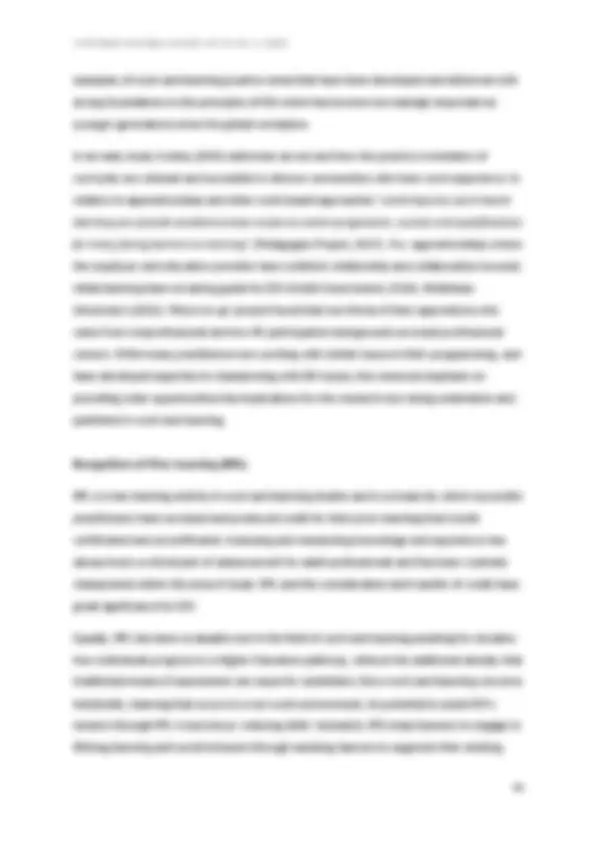
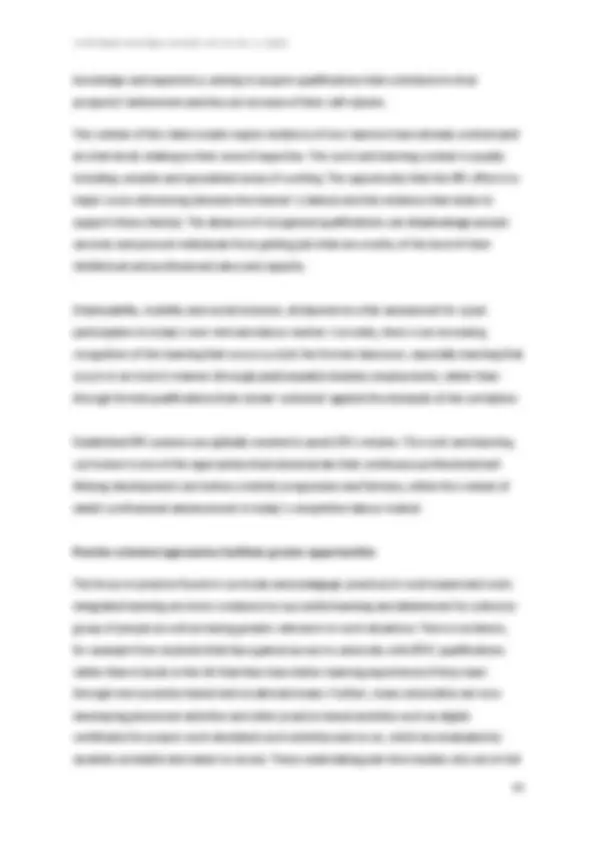
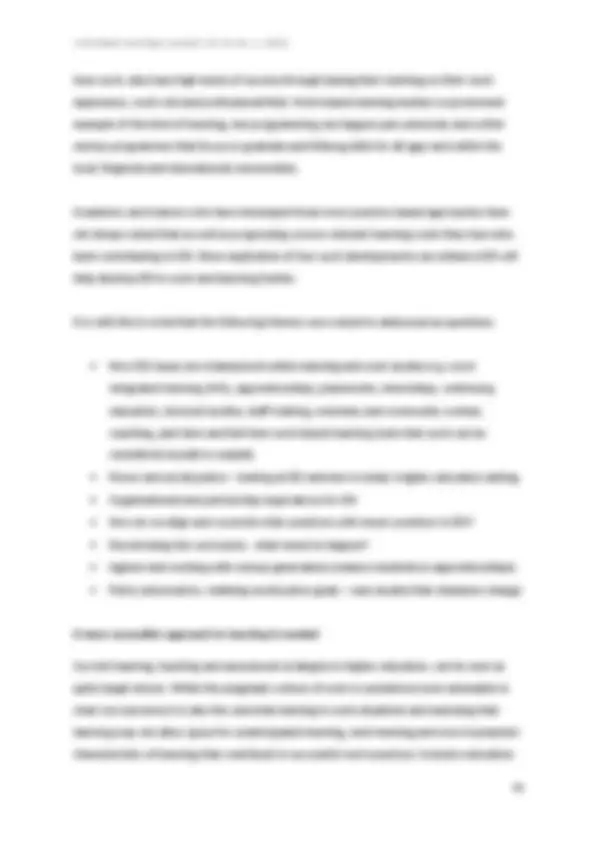
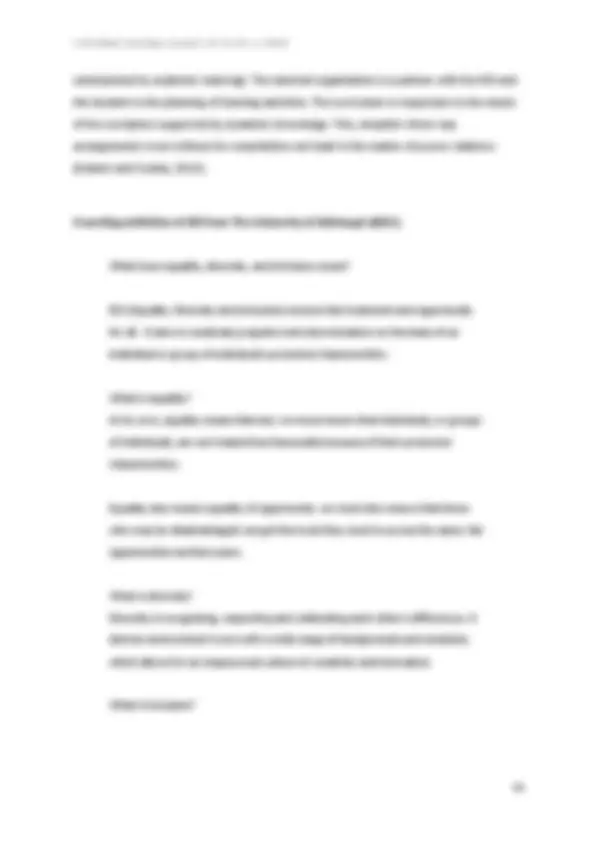
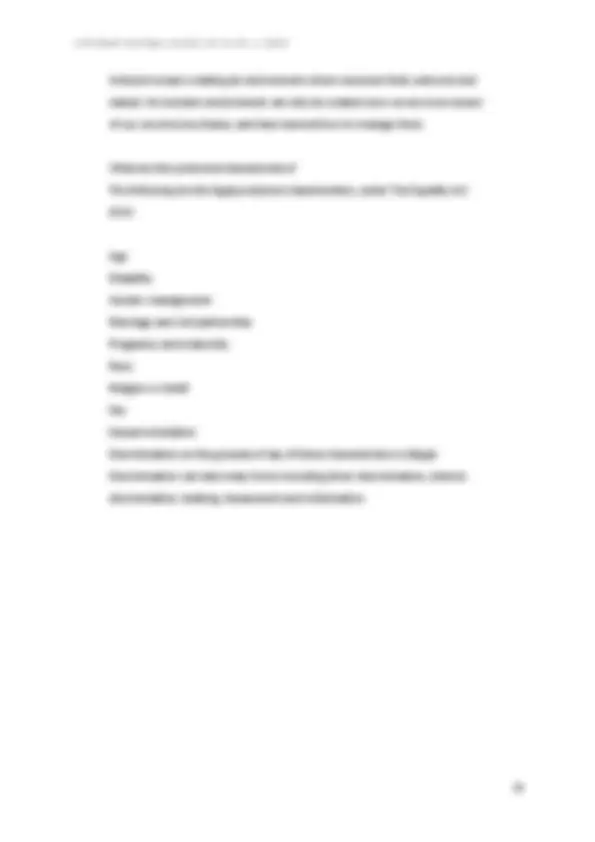
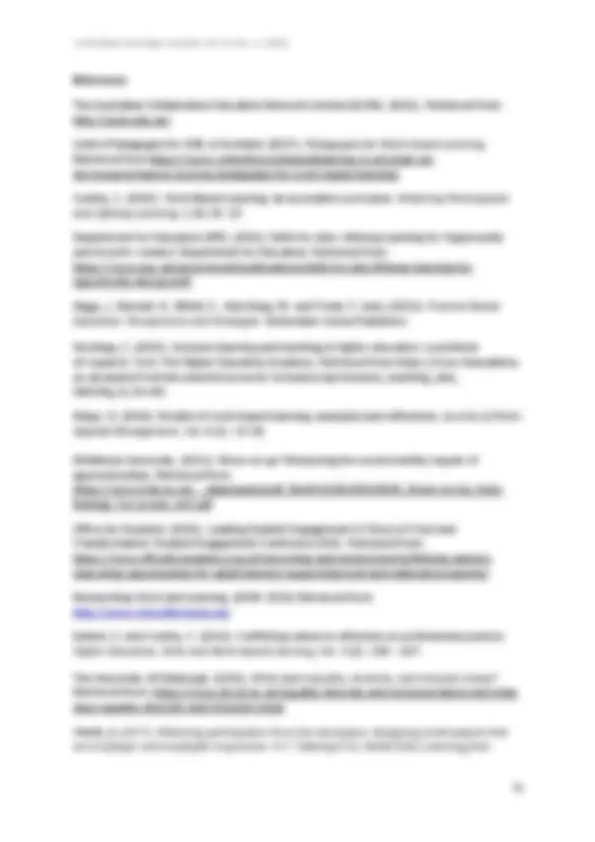


Study with the several resources on Docsity

Earn points by helping other students or get them with a premium plan


Prepare for your exams
Study with the several resources on Docsity

Earn points to download
Earn points by helping other students or get them with a premium plan
Community
Ask the community for help and clear up your study doubts
Discover the best universities in your country according to Docsity users
Free resources
Download our free guides on studying techniques, anxiety management strategies, and thesis advice from Docsity tutors
How people learn in and through participation in work that is mediated by higher education. (h.e.) has been a topic for research and discussion for some ...
Typology: Study notes
1 / 11

This page cannot be seen from the preview
Don't miss anything!







And ELDA NIKOLOU-WALKER Middlesex University, London, UK
Keywords: diversity, equality, inclusion, work and learning
Considering the fields of study and research
How people learn in and through participation in work that is mediated by higher education (h.e.) has been a topic for research and discussion for some time. While this area has supported great strides in social mobility and inclusion, how this h.e. area of practice relates more specifically to Equity, Diversity and Inclusion (EDI) has taken on renewed focus for many practitioners and policy makers.
When considering work and learning areas of practice that support the introduction of EDI and champion change, we appreciate that it is time for practitioners to once again come together to deliberate and share practice about how change can be implemented within h.e. curriculum and pedagogies. We also draw from workplace learning, organisational studies and other fields but the key issues for this research are work and learning in h.e. and access to h.e from levels 3 to 8.
What do we mean by work and why is that important for EDI
The term ‘work’ refers to paid and unpaid work and can in many respects be thought of as all positive, productive endeavours, although this may be problematic and in need of further definition depending on the context / situation of the ‘work’ being discussed.
Within work and learning over the years there have been various definitions in use, but a key point for work-based and work-integrated learning is to think of the wider connotations of work when:
a) preparing students for their life after higher education or b) developing people in a lifelong learning sense throughout their lives
People gain their knowledge to undertake work from both their life’s experience and also from their studies. However, some work is recognised above other work in different societies, different communities and different contexts. For example, domestic work, community work, vocational and unpaid work are all relevant in the h.e. field, but often are not as valued, at time representing deep societal inequalities and endemic failures to address EDI issues.
This research set out to explore and contribute to themes surrounding equality, diversity and inclusion (EDI). Current practitioners in Work and Learning will now need to address the following questions:
Learning and teaching and EDI in the work and learning curriculum
There has been research in this field that addresses the potential of access to h.e. for people wishing to enhance their work practice through further study (Major, 2016). There are many
knowledge and experience, aiming to acquire qualifications that contribute to their prospects’ betterment and thus an increase of their self-esteem.
The context of the claims made require evidence of how learners have already worked (and at what level) relating to their area of expertise. The work and learning context is usually including complex and specialised areas of working. The opportunity that the RPL offers is a major cross-referencing between the learner’s claim(s) and the evidence that exists to support these claim(s). The absence of recognised qualifications can disadvantage people severely and prevent individuals from getting jobs that are worthy of the level of their intellectual and professional value and capacity.
Employability, mobility and social inclusion, all depend on a fair assessment for a just participation in today’s ever intricate labour market. Currently, there is an increasing recognition of the learning that occurs outside the formal classroom, especially learning that occurs in an implicit manner (through paid/unpaid/voluntary employment), rather than through formal qualifications that remain ‘untested’ against the demands of the workplace.
Established RPL systems are globally needed to assist EDI’s mission. The work and learning curriculum is one of the approaches that demonstrate that continuous professional and lifelong development can further a holistic progression and fairness, within the context of adults’ professional advancement in today’s competitive labour market.
Practice-oriented approaches facilitate greater opportunities
The focus on practice found in curricular and pedagogic practices in work-based and work- integrated learning are more conducive to successful learning and attainment for a diverse group of people as well as having greater relevance to work situations. There is evidence, for example from students that have gained access to university with BTEC qualifications rather than A levels in the UK that they have better learning experiences if they learn through more practice-based and vocational means. Further, many universities are now developing placement activities and other practice-based activities such as digital certificates for project work simulated work activities and so on, which are evaluated by students as helpful and easier to access. Those undertaking part time studies who are in full
time work, also have high levels of success through basing their learning on their work experience, work role and professional field. Work-based learning studies is a prominent example of this kind of learning, but programming can happen pan-university and within various programmes that focus on graduate and lifelong skills for all ages and within the local. Regional and international communities.
Academics and trainers who have developed these more practice-based approaches have not always noted that as well as progressing a more relevant learning route they have also been contributing to EDI. More explication of how such developments can enhance EDI will help develop EDI in work and learning further.
It is with this in mind that the following themes were raised to addressed as questions:
A more accessible approach to learning is needed
Current learning, teaching and assessment strategies in higher education, can be seen as quite target driven. Whilst the pragmatic culture of work is sometimes more amenable to clear-cut outcomes it is also the case that learning in work situations and assessing that learning may not allow space for unanticipated learning, tacit learning and more humanistic characteristics of learning that contribute to successful work practices. Inclusive education
discussion and change for vocational and technical education (DfE, 2021), the relationship to universities and these new initiatives is still being formed.
Working models to advance EDI in Australia and in the UK have developed impressive approaches in this practice-oriented field.
In Australia the work integrated learning model (example ACEN) have developed learning and assessment approaches for students on placements that focus on the practice-related aspects of the particular subject discipline being studied. In the UK the work-based learning approach that developed in the early 1990s for part-time lifelong learners focussed on the generic and transdisciplinary work-based capabilities developing curricular that is responsive to the needs of work situations that bring academic scholarship to professional practice including experiential, reflective and authentic approaches.
There is much overlap between WIL and WBL which are largely indefinable, overall observations but nevertheless give food for thought on the topic. It remains constructive to consider these attributes/outcomes/ criteria in relation to EDI. In the field of work and learning curriculum areas in h.e. we recognise some threshold concepts for learning through practice, such as: Embodied, Experiential and participative, Co-constructed, Emergent, Situated and Engaged. Around these conceptual developments, practice theory in relation to work and learning in h.e. can take place. Embracing practice as a gateway to learning enables students that have not had a privileged background but learn well through experience and reflection. These approaches point to forms of social and educational participation and explore new challenging ways of confronting epistemic conformism, hierarchical thinking and class, racial and gender privilege.
Stakeholder perspectives
Partnerships are a key dimension in the field of work and learning. They are often identified as three-way tripartite agreements whereby a learning agreement or contract is negotiated between stakeholders usually an HEI, student and employer. These have been at the heart of the newer apprenticeship models. Each party understands and respects their roles, responsibilities and expectations in developing professional practice capabilities that are
underpinned by academic learning). The external organisation is a partner with the HEI and the student in the planning of learning activities. The curriculum is responsive to the needs of the workplace supported by academic knowledge. This, simplistic three-way arrangements is not without its complexities not least in the matter of power relations (Siebert and Costley, 2013).
A working definition of EDI from The University of Edinburgh (2021)
What does equality, diversity, and inclusion mean?
EDI (Equality, Diversity and Inclusion) ensures fair treatment and opportunity for all. It aims to eradicate prejudice and discrimination on the basis of an individual or group of individual's protected characteristics.
What is equality? At its core, equality means fairness: we must ensure that individuals, or groups of individuals, are not treated less favourably because of their protected characteristics.
Equality also means equality of opportunity: we must also ensure that those who may be disadvantaged can get the tools they need to access the same, fair opportunities as their peers.
What is diversity? Diversity is recognising, respecting and celebrating each other's differences. A diverse environment is one with a wide range of backgrounds and mindsets, which allows for an empowered culture of creativity and innovation.
What is Inclusion?
References
The Australian Collaborative Education Network Limited (ACEN). (2021). Retrieved from: http://acen.edu.au/
Centre Pedagogies for WBL in Scotland. (2017). Pedagogies for Work-based Learning. Retrieved from https://www.centreforworkbasedlearning.co.uk/what-we- do/research/learner-journey/pedagogies-for-work-based-learning/
Costley, C. (2000). Work Based Learning: an accessible curriculum. Widening Participation and Lifelong Learning , 1 (5): 20 -27.
Department for Education (DfE). (2021). Skills for Jobs: Lifelong Learning for Opportunity and Growth. London: Department for Education. Retrieved from: https://www.gov.uk/government/publications/skills-for-jobs-lifelong-learning-for- opportunity-and-growth
Higgs, J., Barnett, R., Billett, S., Hutchings, M. and Trede, F. (eds.) (2012). Practice-Based Education: Perspectives and Strategies. Rotterdam: Sense Publishers.
Hockings, C. (2010). Inclusive learning and teaching in higher education: a synthesis of research. York: The Higher Education Academy. Retrieved from https://www.heacademy. ac.uk/assets/York/documents/ourwork/ inclusion/wp/inclusive_teaching_and_ learning_in_he.doc
Major, D. (2016). Models of work-based learning, examples and reflections. Journal of Work- Applied Management , Vol. 8 (1) : 17-28.
Middlesex University. (2021). Move on up? Measuring the social mobility impact of apprenticeships. Retrieved from: https://www.mdx.ac.uk/__data/assets/pdf_file/0022/600583/MDX_Move-on-Up_Early- findings_For-screen_AW.pdf
Office for Students. (2021). Leading Student Engagement in Times of Crisis and Transformation: Student Engagement Conference 2021. Retrieved from: https://www.officeforstudents.org.uk/news-blog-and-events/events/lifelong-options- improving-opportunities-for-adult-learners-supporting-local-and-national-prosperity/
Researching Work and Learning. (1999- 2019) Retrieved from: http://www.rwlconferences.org
Siebert, S. and Costley, C. (2013). Conflicting values in reflection on professional practice. Higher Education, Skills and Work-based Learning, Vol. 3 (3) : 156 – 167.
The University of Edinburgh. (2021). What does equality, diversity, and inclusion mean? Retrieved from: https://www.ph.ed.ac.uk/equality-diversity-and-inclusion/about-edi/what- does-equality-diversity-and-inclusion-mean
Walsh, A. (2011). Widening participation from the workplace: designing small awards that are employer and employee responsive. In F. Tallantyre & J. Kettle (Eds.) Learning from
Experience in Employer Engagement. York, UK: Higher Education Academy. Retrieved from: https://www.advance-he.ac.uk/knowledge-hub/learning-experience-employer-engagement
Welsh Government. (2018). Equality, Diversity and Inclusion Toolkit for the Work-Based Learning Provider Network. Retrieved from https://gov.wales/sites/default/files/publications/2019-08/equality-diversity-and-inclusion- toolkit-for-the-work-based-learner-provider-network.pdf